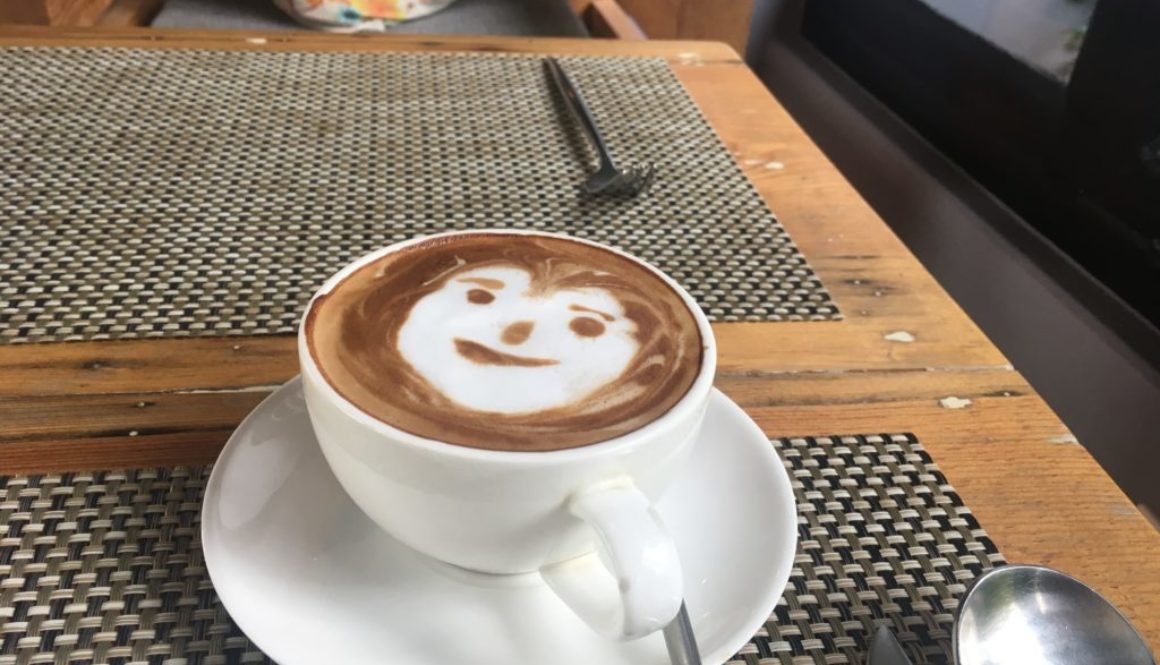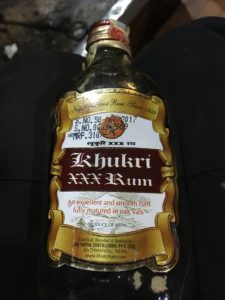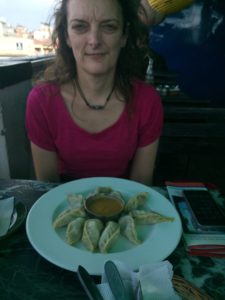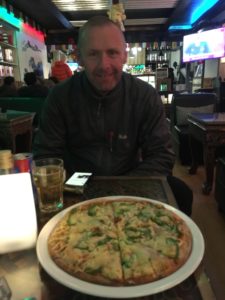Nepalese Cuisine
The traditional food in Nepal has strong influences from its surounding countries India, Tibet and China. The diet is highly vegetarian and is very healthy as it uses large quantities of vegetables and limited use of fats within the cooking. This suited me well as I’ve been vegetarian for almost 30 years now. Rice and potatoes are staple part of the Nepalese diet too.
If you do eat meat, don’t expect to eat beef as cows are the national animal and are 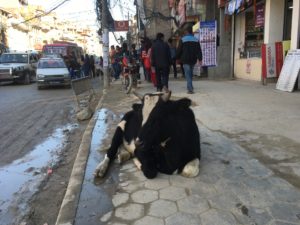 sacred. You’ll often find cows sitting by the side of highways or wandering around the streets in the city. A sight we’re not accustomed to but nobody bothers in Nepal. Chicken is freely available on menus and sometimes there was ‘meat’ although it didn’t identify what it was! We did find out that it was sheep or goat. Occasionally, there was ‘buff’ on the menu too, which was buffalo. Pork is not eaten. Fish is available but as Nepal is a landlocked country it was usually tin tuna.
sacred. You’ll often find cows sitting by the side of highways or wandering around the streets in the city. A sight we’re not accustomed to but nobody bothers in Nepal. Chicken is freely available on menus and sometimes there was ‘meat’ although it didn’t identify what it was! We did find out that it was sheep or goat. Occasionally, there was ‘buff’ on the menu too, which was buffalo. Pork is not eaten. Fish is available but as Nepal is a landlocked country it was usually tin tuna.
In Kathmandu and Pokhara there are a vast array of restaurants serving all variety of international cuisine. It’s easy to find a pizza, sandwich or burgers on the menu together with a selection of Indian, Chinese and Thai restaurants.
On the trek, the tea houses or lodges over recent years have extended their menus to cater to western tastes. I found there was 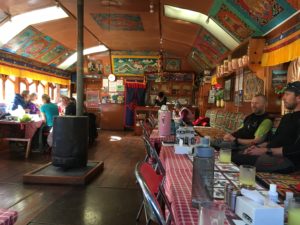 usually always cheese sandwich and chips available, vegetable fried rice (or with meat) and what they called spring rolls. These weren’t like the deep fried crispy variety found in a Chinese cuisine but had been baked and filled with freshly cooked vegetables.
usually always cheese sandwich and chips available, vegetable fried rice (or with meat) and what they called spring rolls. These weren’t like the deep fried crispy variety found in a Chinese cuisine but had been baked and filled with freshly cooked vegetables.
On the trek, all the supplies have to be carried to the mountain villages on either yaks, donkeys or porters but fresh vegetables are 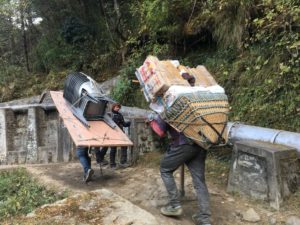 grown in the terraces surrounding the villages. Western treats, such as chocolate bars and pringles were available in the Tea Houses but the higher the altitude, the more pricey they became.
grown in the terraces surrounding the villages. Western treats, such as chocolate bars and pringles were available in the Tea Houses but the higher the altitude, the more pricey they became.
Whilst on the trek, I personally preferred to stick to the traditional 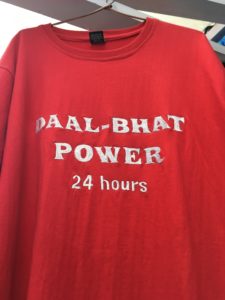 dish of daal bhat as I found it light on the stomach, tasty and nutritious and kept my energy levels up. It was certainly the favourite of the Sherpas who ate it two or three times a day and coined the phrase ‘daal bhat 24 hour power!’
dish of daal bhat as I found it light on the stomach, tasty and nutritious and kept my energy levels up. It was certainly the favourite of the Sherpas who ate it two or three times a day and coined the phrase ‘daal bhat 24 hour power!’
Daal bhat is a complex yet simple dish. It’s a mild vegetable curry usually with a portion of greens served with rice and a poppadom. Accompanying the plate is a bowl of lentil daal, which you pour over the rice. It’s a perfectly balanced meal with a 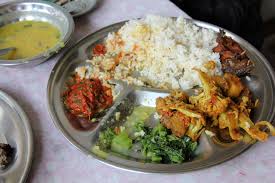 mix of carbohydrates from the rice, protein from the lentil daal and greens and other vitamins from the vegetables.
mix of carbohydrates from the rice, protein from the lentil daal and greens and other vitamins from the vegetables.
No wonder the Sherpas joked about it being a super food!
Another traditional dish which is commonplace throughout is the humble dumpling or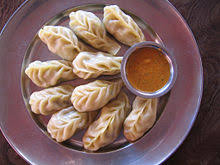 in Nepali it’s called the momo. They either contained a meat or vegetable filling and were either steamed or fried. I always preferred to opt for the steamed variety and although they looked a little pale were very tasty. They were served with a chilli -tomato dip.
in Nepali it’s called the momo. They either contained a meat or vegetable filling and were either steamed or fried. I always preferred to opt for the steamed variety and although they looked a little pale were very tasty. They were served with a chilli -tomato dip.
A variety of noodle soups were commonly found served in the lodges on the trail. Some were made from packet noodles and others were more authentic. 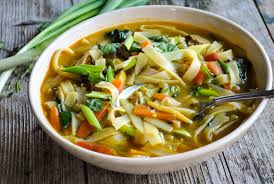
Thukpa is a heart-warming noodle soup originating from Tibet. This dish contains spices and curry flavourings and sometimes contained meat. It was either served as a starter in a small bowl or in some lodges was served as a main course in larger bowls.
Breakfast in the lodges were catered towards the western taste and a 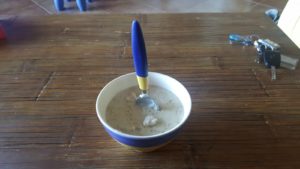 two course breakfast would set me up for the morning without feeling the need to snack in between lunch. It consisted of a starter of porridge sometimes made with water or sometimes made with powdered milk. After having some powdered milk that had gone off we stuck with water
two course breakfast would set me up for the morning without feeling the need to snack in between lunch. It consisted of a starter of porridge sometimes made with water or sometimes made with powdered milk. After having some powdered milk that had gone off we stuck with water 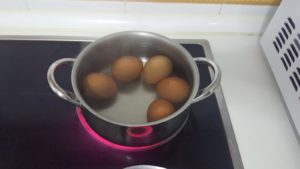 after that! Occasionally, muesli was available. After the porridge, the main course was toast served with either boiled egg, omelette or sometimes a fried egg. If you didn’t fancy any more egg, there was often jam or honey for the toast. There was little variation to the breakfast so towards the end of the trek, my group began to get a little tired with the lack of variety.
after that! Occasionally, muesli was available. After the porridge, the main course was toast served with either boiled egg, omelette or sometimes a fried egg. If you didn’t fancy any more egg, there was often jam or honey for the toast. There was little variation to the breakfast so towards the end of the trek, my group began to get a little tired with the lack of variety.
Each meal was accompanied by copious amounts of tea or coffee although it is recommended to limit the amount of coffee at altitude. The tea is black tea and is served weak without milk, which I found was quite refreshing. Large flasks were brought out with each meal.
In the mountains, fresh milk was limited but in the cities it was freely available. Yoghurt was used to make lassi, a milkshake-like drink, which was either served plain or fruit-flavoured.
There was limited sweet-food available in the mountains. We stayed in one lodge that had a bakery attached to it and slices of freshly baked cakes were available. At other times, if you fancied a desert in the lodges they made a snickers or mars pie! It looked more like a cornish pasty than a pie though with its fluted edges. The chocolate bar was wrapped in pastry and baked in hot oven so when you cut into it you had a delightful chocolatey, gooey mess! Very rich!
Alcohol is freely available in Nepal although it’s not advised in the mountains as it affects your acclimatisation. Foreign beers and wines are available in restaurants in Kathmandu and Pokhara. There’s also local beers served too. The local tipple is Khukri rum.
- Me eating vegetable momo in Kathmandu
- Darren eating yak cheese pizza in Namche Bazaar

